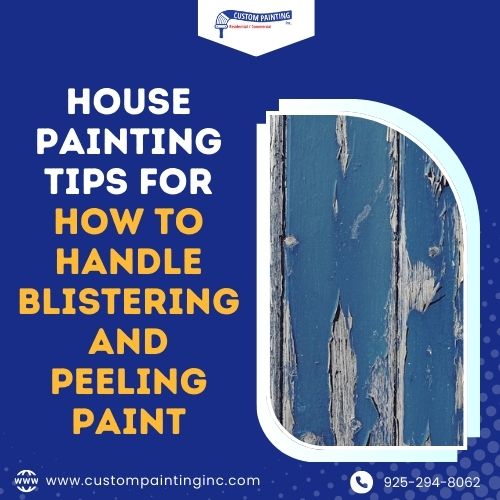Blistering and peeling paint can be a frustrating sight for any homeowner. These blemishes on painted walls, ceilings, and floors can detract from the aesthetic appeal of your house. They can also be a visible sign of underlying issues on the painted surface that need immediate attention.
Handling these problems with paint can help your home remain protected and look its best. In this article, we provide tips on how to address and prevent paint from blistering and peeling so that your house painting efforts are durable and long-lasting.
What is Blistering and Peeling Paint?
Blistering and peeling occurs when paint lifts from the underlying surface, and this lifting phenomenon forms bubbles or blisters that eventually peel away. Several factors can cause this undesirable effect, including:
- Moisture: Water is the most frequent cause of blistering paint. Moisture can infiltrate painted surfaces from both inside and outside the structure, leading to paint lifting off the surface.
- Heat and Sun Exposure: High temperatures and prolonged exposure to sunlight can cause the paint to lose its elasticity, leading to cracking, blistering, and eventually peeling.
- Low-Quality Paint: Inferior quality paint may not be formulated to withstand local weather conditions or the surface it is applied to. The issues with formulation can lead to premature deterioration for the paint.
- Age of the Paint: Over time, all paint will degrade due to the effects of the environment and aging. Older layers of paint are more susceptible to peeling and blistering, especially if new coats are applied without proper surface preparation.
Another key factor in the appearance of blistering and peeling paint is surface preparation. Paint adheres best to surfaces that are clean, dry, and free from any old paint, dirt, or grease. Failing to properly prepare a surface before painting can prevent the new paint from adhering correctly, thus leading to peeling.
Tips for Preventing Blistering and Peeling Paint
Blistering and peeling paint can be an issue for many. But with the right precautions, these issues are often preventable. Here are some practical tips to ensure your paint job remains smooth and durable.
- Check Weather Conditions: Always paint in ideal weather conditions. Extreme heat, cold, or humidity can adversely affect how paint dries and adheres. Aim for mild, dry days for the best results.
- Surface Preparation: Dedicate ample time to prepare the surface. This includes cleaning off dirt, grease, and removing any flaking or peeling paint from previous layers. A clean and smooth surface ensures better adhesion and a smoother finish.
- Use Quality Primer: Apply a high-quality primer before painting, especially on porous surfaces or where old paint has been stripped away. Primer helps in sealing the surface and provides a good foundation for the topcoat.
- Choose Appropriate Paint: Select paint that is suitable for the surface and the environment. For areas exposed to moisture or direct sunlight, opt for formulations designed to withstand these conditions.
- Apply Correct Techniques: Use the right tools and techniques for application. Follow the paint manufacturer’s instructions regarding application methods and the number of coats required.
- Ensure Proper Ventilation: In indoor spaces, proper ventilation helps to manage moisture levels and speeds up the drying process, reducing the likelihood of paint blistering.
By following these tips, you can significantly reduce the chances of experiencing blistering and peeling paint.
How Do Professional Painters Handle Blistering and Peeling Paint?
Dealing with blistering and peeling paint is a challenge that professional painters must tackle effectively. Professionals often follow a systematic approach to repair and prevent further damage. Here’s how they handle the issue:
- Diagnosis of the Problem: Professionals begin by determining the root cause of the blistering or peeling. They may check environmental factors, poor application, or substandard materials.
- Surface Preparation: Key to any quality paint job, professionals ensure the surface is impeccably prepared by removing all loose and flaking paint, cleaning the area, and sanding it to create a smooth base for painting.
- Use of High-Quality Materials: They select the best materials for the job, including premium paints and primers that are appropriate for the specific conditions and surface types of the project.
- Proper Application Techniques: Professional painters apply paint in optimal conditions where they can avoid extreme temperatures and humidity. They use techniques that ensure even coverage and adequate drying time between coats.
- Moisture Control: In cases where moisture is a problem, such as in kitchens or bathrooms, professionals take measures to ensure proper ventilation and may use moisture-resistant paints to prevent future peeling or blistering.
- Ongoing Maintenance Advice: After completing the job, professional painters often provide recommendations for maintaining the paintwork. Proper maintenance helps in extending the life of the paint and preventing future issues.
Conclusion
Handling blistering and peeling paint is about preserving the integrity and longevity of your home’s exterior and interior finishes. By understanding the causes of blistering and peeling paint, such as moisture and improper surface preparation, and implementing the right remedies, you can maintain a vibrant and durable finish.
For specialized assistance, consider our professional services at Custom Painting, Inc. in Pleasanton. We’re always ready to help solve any paint-related issues you might have. To learn more about what we can do for you, call us at 925-294-8062 or fill out our Contact Form.



